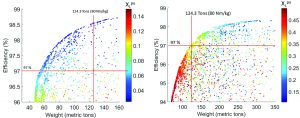Design of Low-Inductance Generator for Large-Scale Wind Turbines
MS student Samith Sirimanna with advisor K. Haran
Recent research by the power and energy group in Illinois has shown that the power electronics cost of a generator can be significantly reduced by introducing multi-port architecture to the generator and controlling only one port using active switches. However, implemen-tation of this technology requires that the synchronous reactance of the generator be smaller than in conventional wind generators.
In previous work, three generator topologies of permanent magnet synchronous machine variants were analyzed for this application. The three topologies are: slotless permanent magnet synchronous generator (PMSG) with a Halbach array rotor, slotted PMSG with a Halbach array of ferrite magnets, and a slotted PMSG with radial magnets. Each generator topology was seen to have different strengths and weaknesses in regard to efficiency, weight, cost, and per-unit inductance.
The slotless PMSG with a Halbach array rotor was the best in terms of achieving highest efficiency, low weight, and a low Xpu. However, the cost of this topology was much higher than the other two. The slotted PMSG with a Halbach array of ferrite magnets provided the lowest cost; however the designs are much heavier and higher in Xpu, which makes the feasibility of using this topology with power electronics questionable. The slotted PMSG with radial magnets provides a middle ground between the first and second topologies by providing a reasonable cost and a reasonably low inductance. Figure 3 shows the results of the study for Topologies 1 and 2 with a color bar representing the Xpu. This research is funded by ARPA-E.
